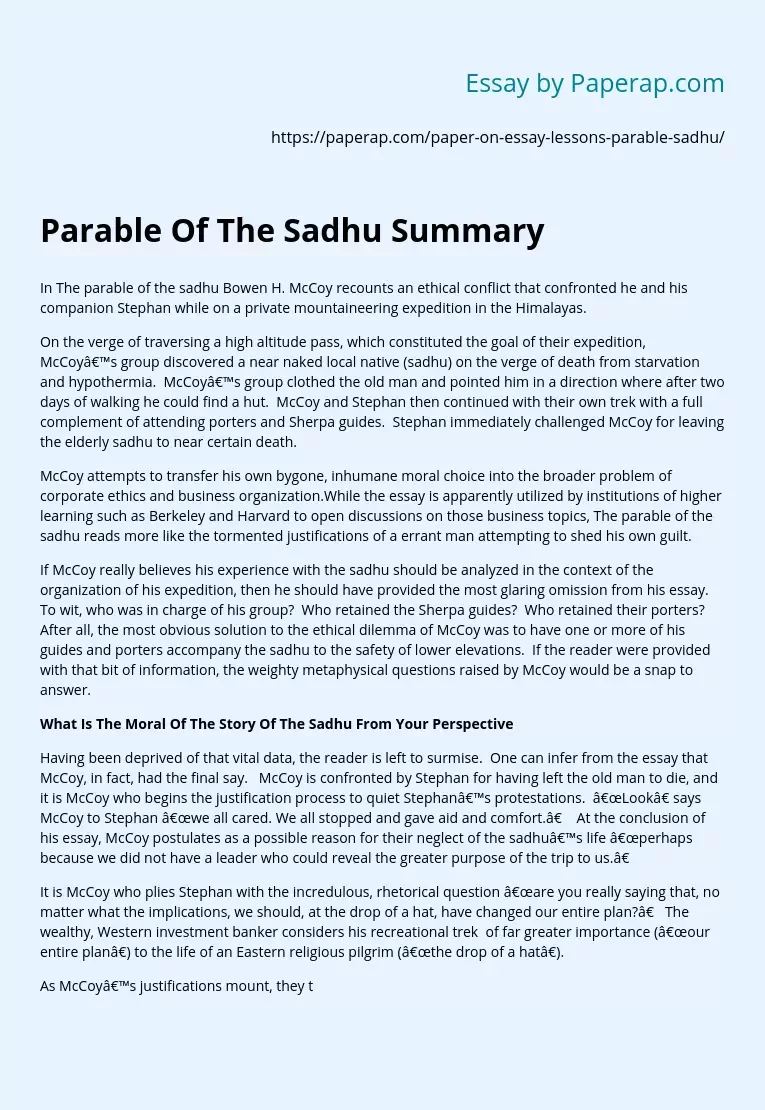Parable Of The Sadhu Summary
In The parable of the sadhu Bowen H. McCoy recounts an ethical conflict that confronted he and his companion Stephan while on a private mountaineering expedition in the Himalayas.
On the verge of traversing a high altitude pass, which constituted the goal of their expedition, McCoy’s group discovered a near naked local native (sadhu) on the verge of death from starvation and hypothermia. McCoy’s group clothed the old man and pointed him in a direction where after two days of walking he could find a hut.
McCoy and Stephan then continued with their own trek with a full complement of attending porters and Sherpa guides. Stephan immediately challenged McCoy for leaving the elderly sadhu to near certain death.
McCoy attempts to transfer his own bygone, inhumane moral choice into the broader problem of corporate ethics and business organization.While the essay is apparently utilized by institutions of higher learning such as Berkeley and Harvard to open discussions on those business topics, The parable of the sadhu reads more like the tormented justifications of a errant man attempting to shed his own guilt.
If McCoy really believes his experience with the sadhu should be analyzed in the context of the organization of his expedition, then he should have provided the most glaring omission from his essay. To wit, who was in charge of his group? Who retained the Sherpa guides? Who retained their porters? After all, the most obvious solution to the ethical dilemma of McCoy was to have one or more of his guides and porters accompany the sadhu to the safety of lower elevations.
If the reader were provided with that bit of information, the weighty metaphysical questions raised by McCoy would be a snap to answer.
What Is The Moral Of The Story Of The Sadhu From Your Perspective
Having been deprived of that vital data, the reader is left to surmise. One can infer from the essay that McCoy, in fact, had the final say. McCoy is confronted by Stephan for having left the old man to die, and it is McCoy who begins the justification process to quiet Stephan’s protestations. “Look” says McCoy to Stephan “we all cared. We all stopped and gave aid and comfort.” At the conclusion of his essay, McCoy postulates as a possible reason for their neglect of the sadhu’s life “perhaps because we did not have a leader who could reveal the greater purpose of the trip to us.”
It is McCoy who plies Stephan with the incredulous, rhetorical question “are you really saying that, no matter what the implications, we should, at the drop of a hat, have changed our entire plan?” The wealthy, Western investment banker considers his recreational trek of far greater importance (“our entire plan”) to the life of an Eastern religious pilgrim (“the drop of a hat”).
As McCoy’s justifications mount, they take on a social darwinistic tone. First, he arbitrarily distinguishes business from philosophy by ascribing “action and implementation – getting things done” exclusively to the former. If business is individuated and apart from philosophy, when then, anything goes. When combined with his pronunciamento that the manager who pauses to contemplate what is “the ’good’ thing to do” threatens the entire “enterprise”, McCoy has all but nullified any evil in his decision to allow the old sadhu to perish in the snow.
Once McCoy acknowledges that hypothetically it could be argued it was not an ethical decision to leave the sadhu behind, he begins to transfer responsibility from any one individual, including himself, to the group as a whole. Having taken the moral load off his own shoulders he ponders where such a thing as “collective or institutional ethics” even exists. He chafes at the idea of the formulation formalized, group ethical rules that clearly delineate what is right and good conduct and what is wrong or evil conduct within an organization. He find this impractical. In support of that idea, he describes how he eschews lawyer and colleague advice to avoid conflicts of interest, instead opting to “feel my way through conflicts.”
Two lessons can be learned from The parable of the sadhu that university professors, and certainly business executives, are not likely to suggest.
First, beware the philosophizing business man who maintains that business and philosophy do not mix. While putting on airs of caring a wit for another member of humanity, Mr. McCoy injects ideas that would justify a “leader” plowing under the weak in achieving the “greater interest” of strong. Even when such an overarching interest consists merely of a recreational pursuit. It is akin to Nike positioning itself as hip and international while at the same time operating inhuman, slave labor sweat shops in Third World countries to maximize its own profits.
Second, beware the man who tells you ethical problems are of such complexity they are beyond the reckoning ability of any single individual. By telling us “the difficulties of dealing with the sadhu were so complex that no one person could handle it”, McCoy perfects his own irresponsibility. I cannot think of a single working class American I have encountered in a half century who would consider the sadhu problem complex in the slightest. I also cannot think of a common man or woman I have met who would have “solved” the sadhu problem as Mr. McCoy saw fit. No, they would not have marched over the pass, porters and Sherpa guides abreast. To one, they would have accompanied the sadhu back to safety.
The essence of The parable of the sadhu is its own antithesis. McCoy, while making the case for the opposite, quite clearly validates the notion that humanitarian philosophers are required to draft black-letter ethics law for the leaders of industry and commerce (including bankers) who left to their own devices would lose the weak to save the strong.
Parable Of The Sadhu Summary. (2019, Dec 05). Retrieved from https://paperap.com/paper-on-essay-lessons-parable-sadhu/

